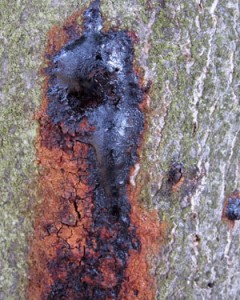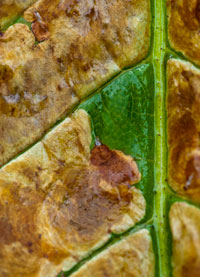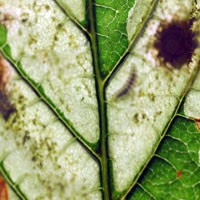Horse Chestnut : National Survey of Leaf Miner Moth

The woodland blog has been reporting on the various threats to the Horse Chestnut tree for some years: see blogs for May 2006, Aug 2006 , Sept 2008 and Dec 2009 . Basically, the tree is under attack by : -
Bleeding canker. The number of reports of bleeding canker on horse chestnut has significantly increased in recent years. The cause of the disease has now been established. It had been thought that the condition was due to a fungus-like organism. However, DNA analysis of damaged and diseased tissue has established the presence of a bacterium Pseudomonas syringae pathovar aesculi. The same bacterium is known to infect the Indian Horse Chestnut (Aesculus indica); it is possible that the bacterium was introduced on imported trees.
A leaf blotch fungus, or Guignardia aesculi . This attacks the leaves so that reddish or brown blotches with yellow borders develop. The blotches may, at a distance, look similar to the damage done by leaf miner
 The horse chestnut leaf miner moth, or Cameraria ohridella that lays its eggs in the leaves. The larvae that hatch from these eggs eat and tunnel their ways through the tissues of the leaves. In consequence, the leaves turn brown in early summer and may be shed from the tree.
The horse chestnut leaf miner moth, or Cameraria ohridella that lays its eggs in the leaves. The larvae that hatch from these eggs eat and tunnel their ways through the tissues of the leaves. In consequence, the leaves turn brown in early summer and may be shed from the tree.
The trees are weakened by these various attacks, losing vigour and vitality as the leaves use light energy to build up sugars and other materials for the plant’s growth and development.
This month a national survey is being launched to investigate the spread of this moth – visit the our web of life website for details about the moth, and also the small parasitic wasp that may help control the moth. Dr Darren Evans gives details of the survey, the moth and wasp in the BBC’s Material World program, which can be followed on the BBC iPlayer.
Comments are closed for this post.
Discussion
I am using a leaf miner trap for horse chestnut, got it from www. Dragonfli. co.uk , its fantastic, doesnt get them all but gets loads, has to be in place by early may as this is when the mating season starts, works by trapping the male moths, you must also pick up all fallen leaves as the pupae live in the leaf litter over winter, my tree is looking so much better after 2 seasons , highly recommend, good luck
As a tree Warden i have experienced the devastation to the foliage of Horse chess nut trees in and around the area of west sussex, and the whole of the south east of the country. The reality of the infection is, it will spread to most areas of the UK, However, there is no evidence to suggest a significant impact on tree health as they can re-flush normally despite many years of leaf miner damage.
Treatment for this infection is the removal and destruction of the fallen leaves, to help reduce the impact of the infection – disease, for the following year.
Having had leaf miner infestation for the last four years in our Horse Chestnut (about 30ft tall), two years ago I took to clearing leaves each Autumn, replacing soil at base of tree with horse manure and spraying the trunk and lower leaves of the tree with a completely unproven combination of essential oils (antibacterial to prevent bleeding canker and natural insect repellents). This maintenance takes about 2 hours per year in total.
Our tree last year produced a few conkers (probably 25% compared to best years) and this year tree is looking the healthiest in the last 10 years with many flowers. There are two smaller nearby trees that have just started to see damage, so I know I am on borrowed time. However has any-one else seen and improvement in their trees this year? I am in Rural Oxfordshire.
In South West France, over a period of 17 years, I have noticed a group of horse chestnut trees of which the leaves each year are turning deep brown by mid-August, dropping by September, then re-appearing, with blossom in the late Autumn. Is this a symptom of disease or a reaction to the climate?
I live on the edge of a conservation area on the border of North Yorks and Co. Durham and a number of trees in my garden are under a Tree Preservation Order. Normally the amount of conkers is prolific but last year there were significantly less. This year the tree has very few leaves and some branches are devoid of leaves altogether. I have looked up various web sites and will ask someone from the local Council to call and inspect the tree. Depending on that initial outcome I will have to decide what further action to take. The tree has probably been in existence for over 40 years. I would add there are also many grey squirrels which inhabit the area and I believe these could be a culprit. I have tried various deterrents but to no avail.


A few years ago now I sent some leaf samples to a Forestry establishment in Alice Holt Hampshire….they were collected from Trago Mill….in Devon…and were confirmed that they had leaf blight….thought they might have contacted Trago to in form them of this and offer some advice…apparently not….the trees are still riddled with the blight.
Clive Cowling
13 July, 2015